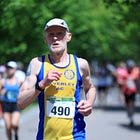(I'm Still a) Road Runner, honey...
Tips For the Tarmac, #5-10, from someone who learned them the hard way.
Picking right on up where the previous post left off - which, in case you missed it, is here:
5. RUN HILLS
There is a saying in running: “Hills are speed work in disguise.” I used to think this was metaphorical. It’s not. It’s literal. The best way to engage in proper speed work is to attend a session hosted by a local running club where someone el…





